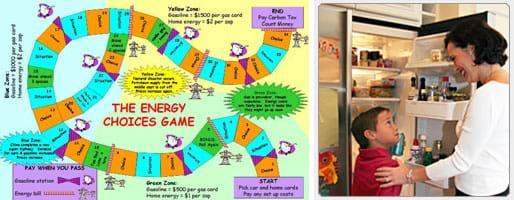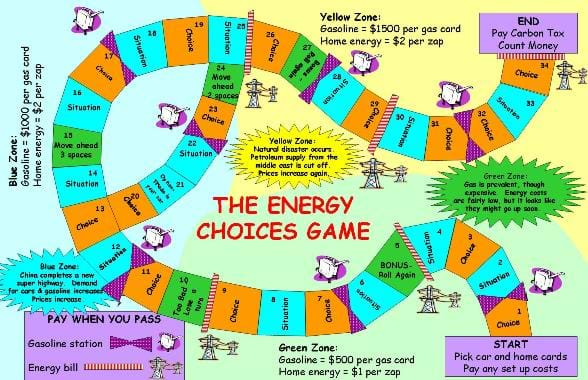Quick Look
Grade Level: 8 (6-8)
Time Required: 1 hours 15 minutes
(two 40-minute classes plus discussion)
Expendable Cost/Group: US $0.00
Group Size: 5
Activity Dependency:
Subject Areas: Physical Science, Science and Technology
NGSS Performance Expectations:

| MS-ESS3-4 |
Summary
Use this board game to introduce the concepts of energy use in our lives and the very real impact that personal choices can have on our energy consumption, energy bills and fuel supply. The game begins as students select cards that define their modes of transportation and home design. The players roll dice and move around the board, landing on "choice" or "situation" blocks and selecting cards that describe consumer choices and real-life events that impact their energy consumption and annual energy bills. As the players pass gasoline stations or energy bill gates, they must pay annual expenses as defined by their original cards, with amounts altered by the choices they've made along the way. Gasoline cards are collected to represent total consumption. Too many gas-guzzling vehicles can result in total depletion of their gasoline supply – at which point everyone must walk or ride the bus. At the end of the game, the players count their remaining dollars to determine the winner. Discussion questions probe the students to interpret what choices they made and which situations they encountered had the most impact on their energy consumption and energy bills. All game board, card and money files are available online free of charge.
Engineering Connection
Many items we use in every day life consume energy. Some items are purposely designed to be highly energy efficient; these are sometimes labeled as Energy Star items. Engineers use energy efficiency as one of the criteria they use to design these products. Engineers also design systems to harness renewable energy sources, even for specific households. Because of engineering advances, homeowners can install small wind turbines, geothermal systems, solar heating or photovoltaic systems, or micro-hydro systems. Depending on which of these systems is installed, they can provide heat or electrical power.
Learning Objectives
After this activity, students should be able to:
- Describe how the depletion of fossil fuels is a serious global issue.
- List three decisions they can make to reduce their own energy consumption.
Educational Standards
Each TeachEngineering lesson or activity is correlated to one or more K-12 science,
technology, engineering or math (STEM) educational standards.
All 100,000+ K-12 STEM standards covered in TeachEngineering are collected, maintained and packaged by the Achievement Standards Network (ASN),
a project of D2L (www.achievementstandards.org).
In the ASN, standards are hierarchically structured: first by source; e.g., by state; within source by type; e.g., science or mathematics;
within type by subtype, then by grade, etc.
Each TeachEngineering lesson or activity is correlated to one or more K-12 science, technology, engineering or math (STEM) educational standards.
All 100,000+ K-12 STEM standards covered in TeachEngineering are collected, maintained and packaged by the Achievement Standards Network (ASN), a project of D2L (www.achievementstandards.org).
In the ASN, standards are hierarchically structured: first by source; e.g., by state; within source by type; e.g., science or mathematics; within type by subtype, then by grade, etc.
NGSS: Next Generation Science Standards - Science
| NGSS Performance Expectation | ||
|---|---|---|
|
MS-ESS3-4. Construct an argument supported by evidence for how increases in human population and per-capita consumption of natural resources impact Earth's systems. (Grades 6 - 8) Do you agree with this alignment? |
||
| Click to view other curriculum aligned to this Performance Expectation | ||
| This activity focuses on the following Three Dimensional Learning aspects of NGSS: | ||
| Science & Engineering Practices | Disciplinary Core Ideas | Crosscutting Concepts |
| Construct an oral and written argument supported by empirical evidence and scientific reasoning to support or refute an explanation or a model for a phenomenon or a solution to a problem. Alignment agreement: | Typically as human populations and per-capita consumption of natural resources increase, so do the negative impacts on Earth unless the activities and technologies involved are engineered otherwise. Alignment agreement: | Cause and effect relationships may be used to predict phenomena in natural or designed systems. Alignment agreement: All human activity draws on natural resources and has both short and long-term consequences, positive as well as negative, for the health of people and the natural environment.Alignment agreement: Scientific knowledge can describe the consequences of actions but does not necessarily prescribe the decisions that society takes.Alignment agreement: |
International Technology and Engineering Educators Association - Technology
-
Analyze how different technological systems often interact with economic, environmental, and social systems.
(Grades
6 -
8)
More Details
Do you agree with this alignment?
-
Analyze how an invention or innovation was influenced by its historical context.
(Grades
6 -
8)
More Details
Do you agree with this alignment?
State Standards
National Council of Teachers of Mathematics - Math
-
recognize and apply mathematics in contexts outside of mathematics
(Grades
Pre-K -
12)
More Details
Do you agree with this alignment?
-
work flexibly with fractions, decimals, and percents to solve problems
(Grades
6 -
8)
More Details
Do you agree with this alignment?
-
understand and use ratios and proportions to represent quantitative relationships
(Grades
6 -
8)
More Details
Do you agree with this alignment?
-
select appropriate methods and tools for computing with fractions and decimals from among mental computation, estimation, calculators, or computers, and paper and pencil, depending on the situation, and apply the selected methods
(Grades
6 -
8)
More Details
Do you agree with this alignment?
-
model and solve contextual problems using various representations, such as graphs, tables, and equations
(Grades
6 -
8)
More Details
Do you agree with this alignment?
-
select, create, and use appropriate graphical representations of data, including histograms, box plot, and scatterplots
(Grades
6 -
8)
More Details
Do you agree with this alignment?
National Science Education Standards - Science
-
Human activities also can induce hazards through resource acquisition, urban growth, land-use decisions, and waste disposal. Such activities can accelerate many natural changes.
(Grades
5 -
8)
More Details
Do you agree with this alignment?
-
Science and technology have advanced through contributions of many different people, in different cultures, at different times in history. Science and technology have contributed enormously to economic growth and productivity among societies and groups within societies.
(Grades
5 -
8)
More Details
Do you agree with this alignment?
New York - Science
-
Construct an argument supported by evidence for how increases in human population and per-capita consumption of natural resources impact Earth's systems.
(Grades
6 -
8)
More Details
Do you agree with this alignment?
Materials List
Per group:
- laminated game board
- game cards (home, car, choice, situation, gasoline cards)
- 1 set play money
- game instructions
- tally sheets (one per player)
Purchase or scavenge from other games:
- 5 playing pieces
- 1 4-sided dice
- 1 8-sided dice
Worksheets and Attachments
Visit [www.teachengineering.org/activities/view/cla_activity3_energy_choices_game] to print or download.Introduction/Motivation
Energy-related issues are particularly relevant to today's students. The limited supply of fossil fuels, combined with detrimental environmental effects associated with energy use, dictate dramatic changes in the way we harness and use energy in the future. This educational game cultivates in students the ability to critically analyze and problem solve, preparing them to interpret energy issues and make sound actions and choices, as voters, consumers and professionals.

Refer to background information about how we use energy and why, as included in the previous activities, which are an integral introduction to this activity.
Procedure
Before Class:
- Print out game files.
- Laminate the board game (optional).
- Cut apart money and game cards.
- Count money into the correct denominations for each student to start the game (see attached instructions).
- Set up game stations around the room.
With the Students:
1. Game preparation
- Hand out instructions and tally sheets.
- Explain each card and how it is used (see game instructions).
- For a large class, display an overhead projection of the game board and take a few turns to model the process.
- Note: A variation of the game is to compete by teams rather than between players on each individual game board. In this case, players are encouraged to help each other and discuss decisions as the game progresses.
2. Play the game
- Divide the class into groups and let students begin to play the game.
- Anticipate requiring another class period to complete the game. Provide each student and the bank with paperclips or envelopes to save their money and game cards. Note the board positions (numbers) where play was interrupted.
- At completion, have students determine their carbon tax and count their remaining money to determine the winner.
3. As a class, review Energy Choices Game discussion questions
- How did the choices you made affect how much money you had at the end?
- Which home system had the most money at the end? Why?
- Which car had with the most gas cards at the end? What do you know about this type of car? (big, gas guzzler) How did having a lot of gas cards affect their financial state?
- What do you think the carbon tax you paid at the end of the game represents? (carbon in fossil fuels causes depletion of fossil fuels and CO2 emissions that contribute to global warming)
- Why did gasoline and home energy prices increase throughout the game? Do you think this will be an issue in your own lives?
- Did any teams run out of gasoline cards? What does this represent? Which transportation contributed most to the depletion of gasoline cards?
Assessment
Post-Activity Assessment
Write Down and Pass In: List three energy choices that you would make the next time you played this game (or in your own lives) to reduce the cost and impact of your energy consumption.
Additional Multimedia Support
Download game resources (including the game board) at Clarkson University's Energy Choices Board Game website at http://internal.clarkson.edu/highschool/k12/project/energychoicesgame.html
Subscribe
Get the inside scoop on all things TeachEngineering such as new site features, curriculum updates, video releases, and more by signing up for our newsletter!More Curriculum Like This

This six-day lesson provides students with an introduction to the importance of energy in their lives and the need to consider how and why we consume the energy we do.
Other Related Information
This activity was originally published by the Clarkson University K-12 Project Based Learning Partnership Program and may be accessed at http://internal.clarkson.edu/highschool/k12/project/energysystems.html.
Copyright
© 2013 by Regents of the University of Colorado; original © 2008 Clarkson UniversityContributors
Susan Powers; Jan DeWaters; and a number of Clarkson and St. Lawrence students in the K-12 Project Based Learning Partnership ProgramSupporting Program
Office of Educational Partnerships, Clarkson University, Potsdam, NYAcknowledgements
This activity was developed under National Science Foundation grant nos. DUE 0428127 and DGE 0338216. However, these contents do not necessarily represent the policies of the National Science Foundation, and you should not assume endorsement by the federal government.
Last modified: September 28, 2023






User Comments & Tips